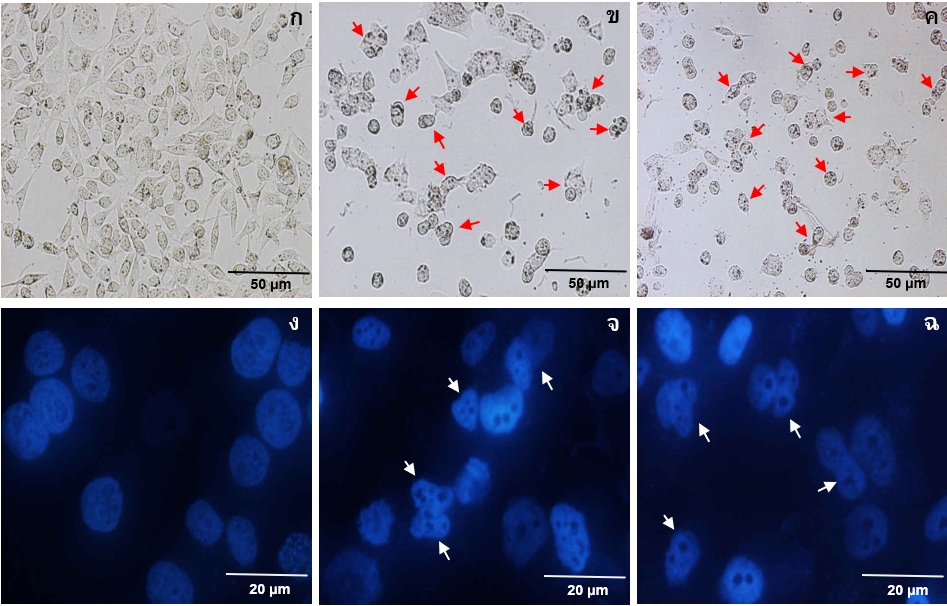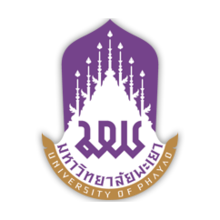ประสิทธิภาพของสารสกัดเปลือกทับทิมต่อเซลล์มะเร็งต่อมลูกหมาก
คำสำคัญ:
ทับทิม, ปริมาณฟีนอลิก, การก าจัดอนุมูล, มะเร็งต่อมลูกหมากบทคัดย่อ
มะเร็งต่อมลูกหมากเป็นมะเร็งที่พบมากในเพศชายและเป็นโรคที่การรักษาทำได้ยาก มีค่าใช้จ่ายสูงและอาจมีผลข้างเคียงจากการรักษา พืชสมุนไพรจึงเป็นทางเลือกหนึ่งที่เหมาะสมในการรักษามะเร็งต่อมลูกหมาก การศึกษามีวัตถุประสงค์เพื่อประเมินปริมาณฟีนอลิกโดยรวมของสารสกัดจากเปลือกทับทิม และฤทธิ์ยับยั้งอนุมูลของสารสกัด และสารสกัดเปลือกถูกนำมาศึกษาหาฤทธิ์ยับยั้งการเจริญเติบโต การเปลี่ยนแปลงลักษณะรูปร่าง และการรวมตัวอัดแน่นของนิวเคลียสของเซลล์มะเร็งต่อมลูกหมากพีซี-3 ผลการศึกษา พบว่า สารสกัดด้วยเอทานอลมีปริมาณฟีนอลิกโดยรวมสูงกว่าสารสกัดด้วยน้ำ (428.03 > 362.47 ไมโครกรัมสมมูลกรดแกลลิก/มิลลิกรัมสารสกัด) สอดคล้องกับความสามารถยับยั้งอนุมูล ABTS เมื่อพิจารณาจากค่าความเข้มข้นของสารที่ยับยั้งอนุมูล 50 เปอร์เซ็นต์ พบว่า สารสกัดด้วยเอทานอล (129.20 ไมโครกรัม/มิลลิลิตร) มีความสามารถมากกว่าสารสกัดด้วยน้ำ (151.27 ไมโครกรัม/มิลลิลิตร) โดยสารสกัดด้วยเอทานอลมีความสามารถใกล้เคียงกับคาเทชิน (128.91 ไมโครกรัม/มิลลิลิตร) แต่น้อยกว่าอีพิแกลโลคาเทชินแกลเลท (71.05 ไมโครกรัม/มิลลิลิตร) ซึ่งสารทั้งสองเป็นกลุ่มควบคุมเชิงบวก สำหรับฤทธิ์ยับยั้งการเจริญเติบโตของเซลล์พีซี-3 เมื่อพิจารณาจากค่าความเข้มข้นของสารที่ยับยั้งการเจริญเติบโต 50 เปอร์เซ็นต์ พบว่า สารสกัดด้วยเอทานอล (455.63 ไมโครกรัม/มิลลิลิตร) มีความสามารถมากกว่าสารสกัดด้วยน้ำ (685.98 ไมโครกรัม/มิลลิลิตร) โดยสารสกัดทั้งสองสามารถยับยั้งการเจริญเติบโตได้ดีกว่าคาเทชิน (897.12 ไมโครกรัม/มิลลิลิตร) แต่น้อยกว่าอีพิแกลโลคาเทชินแกลเลท (180.42 ไมโครกรัม/มิลลิลิตร) และสารสกัดทั้งสองสามารถชักนำเซลล์พีซี-3 ให้เกิดการเปลี่ยนแปลงลักษณะรูปร่าง และเกิดการรวมตัวอัดแน่นของนิวเคลียส โดยสรุปพบว่า สารสกัดเปลือกทับทิมมีปริมาณฟีนอลิกสูงและมีศักยภาพในการต่อต้านอนุมูลอิสระสูง นอกจากนี้ สารสกัดยังมีบทบาทสำคัญต่อการยับยั้งการเจริญของเซลล์พีซี-3
เอกสารอ้างอิง
Pinter O, Mucsi I, Molna J. In vitro antiproliferation in prostate cancer cell lines with cytostatics and combinations with resistance modifiers. in vivo. 2005;19:253-260.
Haskell CM. Principles of cancer chemotherapy. In: Cancer Treatment. 2 nd ed. Haskell CM., (ed). Philadelphia: WB. Saunders. p. 21-42.
Ganry O. Phytoestrogens and prostate cancer risk. Prev Med. 2005;41:1-6.
Morton MS, Chan PS, Cheng C, Blacklock N, Matos-Ferreira A, Abranches-Monteiro L, et al. Lignans and isoflavonoids in plasma and prostatic fluid in men: samples from Portugal, Hong Kong, and the United Kingdom. Prostate. 1997;32:122-128.
Adlercreutz H, Markkanen H, Watanabe S. Plasma concentrations of phyto-oestrogens in Japanese men. Lancet. 1993;342:1209-1210.
Parkin DM, Bray F, Ferlay J, Pisani P. Global cancer statistics, 2002. CA Cancer J Clin. 2005;55:74-108.
Knekt P, Kumpulainen J, Jarvinen R, Rissanen H, Heliovaara M, Reunanen A, et al. Flavonoid intake and risk of chronic diseases. Am J Clin Nutr. 2002;76:560-568.
Neuhouser ML. Dietary flavonoids and cancer risk: evidence from human population studies. Nutr Cancer. 2004;50:1-7.
Lee MM, Gomez SL, Chang JS, Wey M, Wang RT, Hsing AW. Soy and isoflavone consumption in relation to prostate cancer risk in China. Cancer Epidemiol Biomarkers Prev. 2003;12:665-668.
Morton JF. Fruits of warm climates. 1987. Miami: FL. p. 352-355.
Lansky EP, Newman RA. Punica granatum (pomegranate) and its potential for prevention and treatment of inflammation and cancer. J Ethnopharmacol. 2007;109:177-206.
de Pascual-Teresa S, Santos-Buelga C, Rivas-Gonzalo JC. Quantitative analysis of flavan-3-ols in Spanish foodstuffs and beverages. J Agric Food Chem. 2000;48:5331-5337.
van Elswijk DA, Schobel UP, Lansky EP, Irth H, van der Greef J. Rapid dereplication of estrogen compounds in pomegranate (Punica granatum) using on-line biochemical detection coupled to mass spectrometry. Phytochemistry. 2004;65:233-241.
Noda Y, Kaneyuka T, Mori A, Packer L. Antioxidant activities of pomegranate fruit extract and its anthocyanidins: delphinidin, cyaniding, and pelargonidin. J Agric Food Chem. 2002;50:166-171.
Gil MI, Tomas-Barberan FA, Hess-Pierce B, Holcroft DM, Kader AA. Antioxidant activity of pomegranate juice and its relationship with phenolic composition and processing. J Agric Food Chem. 2000;48:4581-4589.
Manasathien J, Indrapichate K, Intarapichet K. Antioxidant activity and bioefficacy of pomegranate Punica granatum Linn. peel and seed extracts. Global J Pharm. 2012;6(2):131-141.
Manasathien J, Kupittayanant S, Indrapichate K. Protective efficacy of pomegranate (Punica granatum Linn., Punicaceae) peel ethanolic extract on UVB-irradiated rat skin. Am-Eurasian J Toxicol Sci. 2011;3(4):250-258.
Hou DX, Ose T, Lin S, Harazoro K, Imamura I, Kubo M, et al. Anthocyanidins induce apoptosis in human promyelocytic leukemia cells: structure-activity relationship and mechanisms involved. Int J Oncol. 2003;23:705-712.
Adams LS, Seeram NP, Aggarwal BB, Takada Y, Sand D, Heber D. Pomegranate juice, total pomegranate ellagitannins, and punicalagin suppress inflammatory cell signaling in colon cancer cells. J Agric Food Chem. 2006;54:980-985.
Kowalski I, Samojedny A, Paul M, Pietsz G, Wilczok T. Effect of kaemferol on the production and gene expression of monocyte chemoattractant protein-1 in J774.2 macrophages. Pharmacological reports. 2005;PR 57:107-112.
Ackland ML, van de Waarsenburg S, Jone R. Synergistic antiproliferative action of the flavonols quercetin and kaempferol in cultured human cancer cell lines. In Vivo. 2005;19:69-76.
Khan N, Hadi N, Afaq F, Syed DN, Kweon MH, Mukhtar H. Pomegranate fruit extract inhibits prosurvival pathways in human A549 lung carcinoma cells and tumor growth in athymic nude mice. Carcinogenesis. 2007;28:163-173.
Lansky EP, Harrison G, Froom P, Jiang WG. Pomegranate (Punica granatum) pure chemicals show possible synergistic inhibition of human PC-3 prostate cancer cell invasion across Martigel. Invest New Drugs. 2005;23:121-122.
Lansky EP, Jiang W, Mo H, Bravo L, Froom P, Yu W. Possible synergistic prostate cancer suppression by anatomically discrete pomegranate fractions. Invest New Drugs, 2005;23:11-20.
Albrecht M, Jiang W, Kumi-Diaka J, Lansky EP, Gommersall LM, Patel A, et al. Pomegranate extracts potently suppress proliferation, xenograft growth, and invasion of human prostate cancer cells. J Med Food. 2004;7:274-283.
Awad AB, Fink CS. Phytosterols as anticancer dietary components: evidence and mechanism of action. Journal of Nutrition. 2000;130:2127-2133.
Awad AB, Burr AT, Fink CS. Effect of resveratrol and beta-sitosterol in combination on reactive oxygen species and prostaglandin release by PC-3 cells. Prostaglandins Leukot Essent Fatty acids. 2005;72:219-226.
Malik A, Afaq F, Sarfaraz S, Adhami VM, Syed DN, Mukhtar H. Pomegranate fruit juice for chemoprevention and chemotherapy of prostate cancer. Proc Natl Acad Sci USA. 2005;102:14813-14818.
Singleton VL, Orthofer R, Lamuela-Raventos RM. Analysis of total phenols and other oxidation substrates and antioxidations by mean of Folin-Ciocateu reagent. Methods. Enzymol. 1999;299:152-178.
Arnao MB, Cano A, Acusta M. The hydrophilic and lipophilic contribution to total antioxidant activity. Food Chem. 2001;7:239-244.
Re R, Pellegrini N, Proteggente A, Pannala A, Yang M, Rice-Evans C. Antioxidant activity applying an improved ABTS radical action decolorization assay. Free Radic Biol Med. 1999;26:1231-1237.
Mosmann T. Rapid colorimetric for cellular growth and survival: application to proliferation and cytotoxicity assay. J Immunol Methods. 1983;65:55-63.
Manasathien J, Indrapichate K. Apoptosis of MCF-7 cancer cell induced by pomegranate (Punica granatum L.) peel extract. Suranaree J Sci Technol. 2016;21(1):63-74.
Widyawati PS, Budianta TDB, Kusuma FN, Wijaya EL. Differences of solvent polarity to phytochemical content and antioxidant activity of Pluchea indica Less leaves extracts. Int J Pharmacogn Phytochem Res. 2014;6:850-855.
Manasathien J. Effects of mangosteen hull extracts on bioefficacy and antiproliferation of human breast and prostate carcinoma cell lines. Suranaree J Sci Technol. 2017;24(4):475-488.
Chidambara Murthy KN, Jayaprakasha GK, Singh RP. Studies on antioxidant activity of pomegranate (Punica granatum) peel extract using in vivo models. J Agric Food Chem. 2002;50:4791-4795.
Haddad AQ, Venkateswaran V, Viswanathan L, Teahan SJ, Fleshner NE, Klotz LH. Novel antiproliferative flavonoids induce cell cycle arrest in human prostate cancer cell lines. Prostate Cancer Prostatic Dis. 2006;9:68-76.
Henry-Mowatt J, Dive C, Martinou JC, James D. Role of mitochondrial membrane permeabilization in apoptosis and cancer. Oncogene. 2004;23:2850-2560.
Ashkenazi A, Dixit Amundson SA, Myers TG, Scudiero D, Kitada S, Reed JC, Fornace AJ. An informatics approach identifying markers of chemosensitivity in human cancer cell lines. Cancer Res. 2000;60:6101-6110.
Aslam MN, Lansky EP, Varani J. Pomegranate as a cosmeceutical source: Pomegranate fractions promote proliferation and procollagen synthesis and inhibit matrix metalloproteinase-1 production in human skin cells. J Ethnopharmacol. 2006;103:311-318.

ดาวน์โหลด
เผยแพร่แล้ว
รูปแบบการอ้างอิง
ฉบับ
ประเภทบทความ
สัญญาอนุญาต
ลิขสิทธิ์ (c) 2022 วารสารนเรศวรพะเยา

อนุญาตภายใต้เงื่อนไข Creative Commons Attribution-NonCommercial-NoDerivatives 4.0 International License.
ผู้นิพนธ์ต้องรับผิดชอบข้อความในบทนิพนธ์ของตน มหาวิทยาลัยพะเยา ไม่จำเป็นต้องเห็นด้วยกับบทความที่ตีพิมพ์เสมอไป ผู้สนใจสามารถคัดลอก และนำไปใช้ได้ แต่จะต้องขออนุมัติเจ้าของ และได้รับการอนุมัติเป็นลายลักษณ์อักษรก่อน พร้อมกับมีการอ้างอิงและกล่าวคำขอบคุณให้ถูกต้องด้วย







